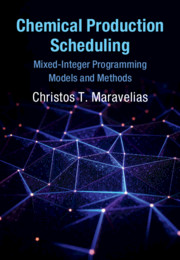Book contents
- Chemical Production Scheduling
- Cambridge Series in Chemical Engineering
- Chemical Production Scheduling
- Copyright page
- Dedication
- Contents
- Preface
- Part I Background
- Part II Basic Methods
- Part III Advanced Methods
- Part IV Special Topics
- 12 Solution Methods: Sequential Environments
- 13 Solution Methods: Network Environments
- 14 Real-Time Scheduling
- 15 Integration of Production Planning and Scheduling
- Index
- References
12 - Solution Methods: Sequential Environments
from Part IV - Special Topics
Published online by Cambridge University Press: 01 May 2021
- Chemical Production Scheduling
- Cambridge Series in Chemical Engineering
- Chemical Production Scheduling
- Copyright page
- Dedication
- Contents
- Preface
- Part I Background
- Part II Basic Methods
- Part III Advanced Methods
- Part IV Special Topics
- 12 Solution Methods: Sequential Environments
- 13 Solution Methods: Network Environments
- 14 Real-Time Scheduling
- 15 Integration of Production Planning and Scheduling
- Index
- References
Summary
The goal of the present chapter, as well as Chapter 13, is to illustrate how problem features can be exploited to develop more efficient models and/or specialized algorithms. We start, in the present chapter, with solution methods for problems in sequential environments. Specifically, we discuss four methods: (1) a decomposition approach, in Section 12.1; (2) preprocessing algorithms and tightening constraints, in Section 12.2; (3) a reformulation and tightening constraints based on time windows, in Section 12.3; and (4) a two-step algorithm, combining the advantages of discrete and continuous time models, in Section 12.4. While all presented methods can be applied to a wide range of problems, we present them for a subset of problems for the sake of brevity. Also, all methods can be applied to problems under different processing features, but to keep the presentation simple, we discuss problems with no shared utilities and no storage constraints.
Keywords
- Type
- Chapter
- Information
- Chemical Production SchedulingMixed-Integer Programming Models and Methods, pp. 289 - 317Publisher: Cambridge University PressPrint publication year: 2021

